AJKOER
Radically Dubious
    
Posts: 3026
Registered: 7-5-2011
Member Is Offline
Mood: No Mood
|
|
A Dual Experiment with Al/Fe/H2O2/Citric Acid/Sea Salt: Implied Dangers & Benefits of Al3+
The purpose of the thread is twofold. First, based upon a review of two articles noting the pro-oxidant property of the aluminum ion, it is
reflective of a likely serious health risk pose by the ability of aqueous Al3+ to recycle transition metals (like Fe, Cu, Mn,..) to lower valence
states in Fenton and Fenton like reactions, contributing to so-called oxidative stress related diseases (including Alzheimer's disease, various
cancers,...). As there are still currently consumer products (like deodorants) that employ aluminum compounds for personal consumption (including
aluminum chlorohydrate based deodorants, which is one of the covered class of compounds) which apparently may pose a significant health risk (at least
in the United States, as my consultation with a medical doctor did suggest that the use of such aluminum compounds have been banned in Europe), this
thread is a wake-up call.
The second chemistry related goal is to use the recycling ability of the aluminum ion with respect to transition metals to their lower valence states
as a means to foster chemical decomposition reactions.
The first alluded to article is ‘Oxidative Stress Gated by Fenton and Haber Weiss Reactions and Its Association with Alzheimer’s Disease’ by
Tushar Kanti Das, et al, published in Archives of Neuroscience, July 2014 2(3): e20078, DOI: 10.5812/archneurosci.20078.
The authors cite, in Figure 4, “ Formation of Aluminum Superoxide Semi reduced Radical Ion and Aluminum Superoxide Complex (43)”, with described
reactions proceeding as follows (also adopting notation and water complexing from the second article):
[Al(H2O)4](3+) + O2•− <-> [Al(O2•−)(H2O)4](2+)
[Al(O2•−)(H2O)4](2+) + Fe(3+) --> O2 + [Al(H2O)4](3+) + Fe(2+)
And, in the presence of H+ :
[Al(H2O)4](3+) + O2•− + H+ <-> [Al(O2•−)(H+)H2O)4](3+)
[Al(O2•−)(H+)H2O)4](3+) + [Al(O2•−)(H+)H2O)4](3+) --> 2 [Al(H2O)4](3+) + H2O2 + O2
Note per below, the action of hydrogen peroxide on ferric also leads to ferrous:
H2O2 = H+ + HO2-
Fe(3+) + HO2- --> Fe(2+) + •HO2 ( or, pH> 4.88, H+ + O2•− )
Hydroxyl radical can also be formed via the classic Fenton reaction:
Fe(2+) + H2O2 --> Fe(3+) + •OH + OH-
Another work: ‘Pro-oxidant Activity of Aluminum: Stabilization of the Aluminum Superoxide Radical Ion’ by J. I. Mujika, F. Ruiperez, I. Infante,
J. M. Ugalde, C. Exley, and X. Lopez in J., published in Phys. Chem. A 2011, 115, 6717–6723, American Chemical Society, dx.doi.org/10.1021/jp203290b
.Link:
https://s3.amazonaws.com/academia.edu.documents/50520932/Pro... .
In the Mujika article to quote “In addition, the presence of LMM ligands such as citrate could also have an indirect effect in the oxidation
capacity of aluminum by augmenting the bioavailability of Al3+ species, shifting the formation of Al(OH)4- to higher pH’s. However, one should also
take into account the effect of citrate chelation itself in the thermodynamic equilibrium of [AlO2•]2+ formation.”
ADDITIONAL THEORY FOR AN EXPERIMENT
With respect to the chemistry, some more reactions relating to formation of superoxide, solvated electrons electrons and ferric salts per a planned
experiment:
•OH + H2O2 = O2•− + H+ + H2O (or HO2• for pH < 4.88)
Al --> Al3+ + 3 e-
Fe2+ + 2 e- --> Fe
-------------------------
Net Electrochemical Cell: Al + Fe2+ --> Al3+ + Fe + e-
e- + n H2O = e-(aq)
e-(aq) + O2 = O2•−
From the added presence of Citric acid crystals,
Fe2+ --> Fe3+ + e-
e- + OH• --> OH-
--------------------------
Fe2+ + OH• --> Fe3+ + OH- (the creation of a basic ferric citrate from a hydroxyl radical attack)
Yet more chemistry from a prior thread (see http://www.sciencemadness.org/talk/viewthread.php?tid=77977 ):
Quote: Originally posted by AJKOER  | Here is an extract on one of my prior discussion of Fenton-type reactions proceeding from in situ formed H2O2, to quote:
"Well, let's start with some possible Fenton based reactions creating the hydroxyl radicals, .OH and the superoxide anion, .O2- . As a reference, see,
for example, "Generation of Hydroxyl Radicals from Dissolved Transition Metals in Surrogate Lung Fluid Solutions" by Edgar Vidrio, et al at http://www.ncbi.nlm.nih.gov/pmc/articles/PMC2626252/ . Cited reactions :
Cu(l)/Fe(II) + O2(aq) → Cu(ll)/Fe(III) + .O2-
As an alternate reference for the above reaction (which I have personally performed on Cuprous citrate using an air pump from an old fish tank), see
for example, https://books.google.com/books?id=WjReuSXxl4YC&pg=PA17&a...
The reaction chain continues as:
Cu(l)/Fe(II) + .O2- +2 H+ → Cu(ll)/Fe(III) + HOOH
Cu(l)/Fe(II) + HOOH → Cu(ll)/Fe(III) + .OH + OH-
Net of the last three reactions:
3 Cu(l)/Fe(II) + O2(aq) +2 H+ → 3 Cu(ll)/Fe(III) + .OH + OH-
And, in the presence of sunlight (or a reductant like Citric or Ascorbic acid), a cyclic reaction could ensue in the case of sunlight:
Cu(ll)/Fe(lll) (aq) + hv → Cu(l)/Fe(ll) (aq) + HO• + H+ "
.......
[Edited on 11-11-2017 by AJKOER] |
An added quote from the Vidrio's work detailing the limited recycling ability of citrate (and ascorbate):
“Similar reactions can occur with Cu, Cr and Ni. Furthermore, biological chelators and reductants can greatly enhance the production of ROS (Burkitt
et al., 1991; Engelmann et al., 2003; Wenk et al., 2001). For example, in the presence of ascorbate (Asc), a biological reductant, the oxidized form
of the transition metal produced by the Fenton reaction can be reactivated (R2 and R3), thus allowing additional ROS to be produced.
Fe(III) + Ascn → Fe(II) + Ascn+1 (R2)
Cu(II) + Ascn → Cu(I) + Ascn+1 (R3) “
AN EXPERIMENT
I conducted an interesting dual experiment by add 10 grams of citric acid crystals and 120 ml of 3% hydrogen peroxide (normally acidified to
stabilize) to the metals of aluminum (flamed treated, see discussion at http://www.sciencemadness.org/talk/viewthread.php?tid=94166#...), a very small amount of iron filings and some sea salt in two vessels in a
microwave for 1 minute. The two reaction mixes where then simultaneously subjected to a cooldown period of 30 minutes in a freezer. This was followed
by aeration from an air pump, but in only one solution (I select the mix that appeared a little darker) for one hour. At the end of the hour a picture
was taken and the air hose placed in the other vessel for the same treatment time. The goal of the experiment would be to see if there is a visible
difference in the appearance of the solution as a joint consequence of aeration and the presence of Al3+ at various stages of the experiment.
RESULTS
Clearly the use of aeration accelerated miscellaneous reactions. This may be due to either largely from the recycle associated with O2/Citrate acid
(as detailed above), or largely assisted by Al3+ complex formation leading to more ferrous creation, or neither is discernibly more influential.
However, a close examination of the pictures notes that all Al was eventually consumed, but this was not the case one hour before termination of the
experiment as there was visible Al in the first aerated solution, which apparently dissolved without the help of O2 (or the Al3+) in the last hour.
But, during the last hour, the starting Al3+ conc was likely higher for solution 2 than for when the 1st solution that was aerated an hour earlier,
which implies the observed equal or darker coloration achieved for Solution 2 could be due to the higher average Al3+ concentration perhaps by way of
a more significantly powerful aluminum complex formation.
Pictures to follow!
-------------------------------------------------------------------------
Note reference (43) is “Exley C. The coordination chemistry of aluminium in neurodegenerative disease. Coordina Chmst Rev. 2012;256(19-20):2142–6.
Here is the Abstract and Highlights:
“The coordination chemistry of aluminium in neurodegenerative disease, Link: https://doi.org/10.1016/j.ccr.2012.02.020
Abstract
The coordination chemistry of a metal ion defines its optimal association with a biomolecule such that its binding by specific ligands on that
molecule confers function and biological purpose. Aluminium is a non-essential metal with no known biological role which means that its coordination
neurochemistry defines aluminium's putative role in a number of neurodegenerative diseases. In examining this chemistry it is found that very little
is known about the complexes formed and ligands involved in aluminium's interactions with neurochemically-relevant ligands. Aluminium's action as a
pro-oxidant as well as an excitotoxin are highlighted while the evidence for its interactions with amyloid beta, tau and DNA are discussed and it is
concluded that it is too early to discount these ligands as targets for the neurotoxicity of aluminium.
Highlights
► There are few quantitative data describing the coordination chemistry of aluminium in neurodegenerative disease. ► One compelling line of
evidence relates to the putative aluminium superoxide semi-reduced radical ion (AlO22+) and its powerful action as a pro-oxidant. ► Another
important candidate is aluminium's complex with ATP and its potential to disrupt neuronal signalling and induce excitotoxicity. ► Though there are
no quantitative data to describe aluminium's interactions with amyloid beta this does not preclude their association in the brain. ► The biological
reactivity of aluminium supports myriad as yet unidentified interactions with biomolecules associated with brain function in health and disease.”
[Edited on 7-10-2018 by AJKOER]
|
|
|
AJKOER
Radically Dubious
    
Posts: 3026
Registered: 7-5-2011
Member Is Offline
Mood: No Mood
|
|
Bottom picture is minutes after microwave treatment.
Top picture is after freezing solutions for 30 minutes.
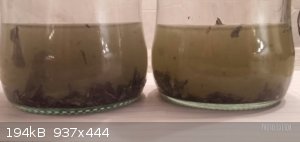
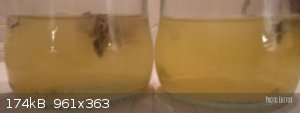
[Edited on 7-10-2018 by AJKOER]
|
|
|
AJKOER
Radically Dubious
    
Posts: 3026
Registered: 7-5-2011
Member Is Offline
Mood: No Mood
|
|
Bottom photo is at end of experiment
Other photos are after aeration of solution on right, note there is still undissolved aluminum at this point.
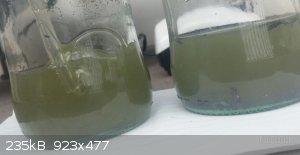
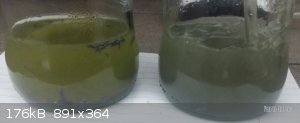
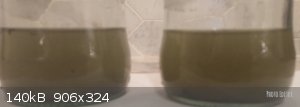
[Edited on 7-10-2018 by AJKOER]
|
|
|
AJKOER
Radically Dubious
    
Posts: 3026
Registered: 7-5-2011
Member Is Offline
Mood: No Mood
|
|
No aluminum left in either vessels
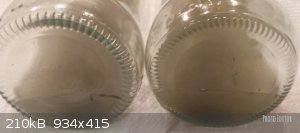
|
|
|
symboom
International Hazard
    
Posts: 1143
Registered: 11-11-2010
Location: Wrongplanet
Member Is Offline
Mood: Doing science while it is still legal since 2010
|
|
Alright AJKOER great work
Getting out there and doing experiments.
Let the age of Muspratt and Davy proceed
[Edited on 7-10-2018 by symboom]
|
|
|
fusso
International Hazard
    
Posts: 1922
Registered: 23-6-2017
Location: 4 ∥ universes ahead of you
Member Is Offline
|
|
Why the solutions look muddy?
|
|
|
AJKOER
Radically Dubious
    
Posts: 3026
Registered: 7-5-2011
Member Is Offline
Mood: No Mood
|
|
Good observation!
There is the usual residual black residue from store brand Al foil (SiO2 perhaps).
Also, as I mentioned in the opening thread, some chemistry suggests a basic salt formation, and many such basic salts are not soluble as the solutions
pH increases.
Interestingly, I noticed the viscosity of both solution appears a little elevated (guess is clear Al(OH)3 not dissolved by Citric acid) so particles
may not be settling down quickly after being jarred.
I am also planning on posting a smarter picture after some time following settlement.
[Edited on 7-10-2018 by AJKOER]
|
|
|
AJKOER
Radically Dubious
    
Posts: 3026
Registered: 7-5-2011
Member Is Offline
Mood: No Mood
|
|
A summary observation which may not be clear from my thread, as to what exactly the aluminum ion is doing here. In short, there is the so called
reversible metal auto-oxidation reaction below:
Fe(ll) + O2(aq) ⇆ Fe(lll) + •O2-
which can contribute to superoxide radical anion formation that leads to H2O2,..., needed for a Fenton reaction with associated problematic radicals.
Apparently, the negatively charged superoxide anion is strongly attracted to the very positive Al3+ leading to an intermediate with •O2- that takes
a one sided direction on the reversible metal auto-oxidation reaction pushing Fe(lll) to Fe(ll) in the presence of the aluminum superoxide complex.
This makes the cyclic reaction system detailed above by Edgar Vidrio in his paper "Generation of Hydroxyl Radicals from Dissolved Transition Metals in
Surrogate Lung Fluid Solutions" even more problematically efficient.
[Edited on 7-10-2018 by AJKOER]
|
|
|
AJKOER
Radically Dubious
    
Posts: 3026
Registered: 7-5-2011
Member Is Offline
Mood: No Mood
|
|
Quote: Originally posted by symboom  | Alright AJKOER great work
Getting out there and doing experiments.
Let the age of Muspratt and Davy proceed
[Edited on 7-10-2018 by symboom] |
Thanks Symboom!
I do not often get an opportunity to potentially save lives by highlighting possible dangerous (in my opinion and others) agents and get to do
experiments as well
|
|
|
woelen
Super Administrator
        
Posts: 7976
Registered: 20-8-2005
Location: Netherlands
Member Is Offline
Mood: interested
|
|
The muddy appearance may also be due to the presence of carbon in the Al-foil. I also noticed this effect in many experiments with Al-foil, also in
experiments with acids.
I also have very pure Al (99.99+ % in the form of small needle-like pieces) and when this is used in experiments with acids I get clear solutions.
|
|
|
AJKOER
Radically Dubious
    
Posts: 3026
Registered: 7-5-2011
Member Is Offline
Mood: No Mood
|
|
Woelen:
Thanks for the comment as apparently having very noble carbon forming a large surface area cathodic zone is a very good thing when the goal is to put
the Al into solution. Here is a quote from a reference (see https://www.corrosionpedia.com/galvanic-corrosion-of-metals-...):
"The carbon fibers are electrically conductive and electrochemically very noble. Therefore, when a metal is electrically connected to a CFRP, it is
more susceptible to galvanic corrosion. This situation becomes worse when a large surface area of carbon composite components is coupled to small
metallic parts (such as fasteners, bolts and nuts). In these circumstances, the rate of galvanic corrosion is extremely high due to the high cathode
to anode surface area ratio (Ac/Aa).....
....
Aluminum alloys are extremely vulnerable when they are coupled to a carbon composite"
The story gets even better per another reference, while not in the presence of oxygen (but possibly latter after the air pump stops and the dissolved
oxygen is consumed):
"The production of the reactive oxidant (i.e., hydroxyl radical) by the Fenton-like reaction (Fe(III)/H2O2) was greatly improved by the addition of
carbon materials such as powdered activated carbon (PAC) and carbon nanotubes (CNT)."
Source: 'Enhanced production of reactive oxidants by Fenton-like reactions in the presence of carbon materials'. Available from: https://www.researchgate.net/publication/276120744_Enhanced_...
Scroll down to read the entire article.
--------------------------------------------
Interestingly, I wonder if there are any medical opinions on the long term exposure to activated carbon pills, charred food, etc. given carbon
apparent ability to accelerate redox reactions.
[Edit] Apparently some suspicion that it may be cancerous (see https://www.superfoodly.com/activated-charcoal-uses-side-eff... ).
[Edited on 8-10-2018 by AJKOER]
|
|
|
AJKOER
Radically Dubious
    
Posts: 3026
Registered: 7-5-2011
Member Is Offline
Mood: No Mood
|
|
Final pictures where the small amount of white salt is thought to be ferrous citrate and the green tinted solution is likely ferric citrate as pH is
above 2 (see https://en.wikipedia.org/wiki/Iron(III)_citrate ).
Neutralization of both solutions with sodium bicarbonate maintain some green tint and suspected to be ferrous bicarbonate. A large amount of white
precipitate also created, could be prior created insoluble ferrous citrate, basic aluminum citrate, basic aluminum carbonate, and/or aluminum
hydroxide.
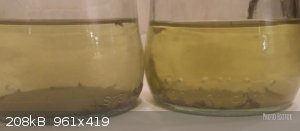
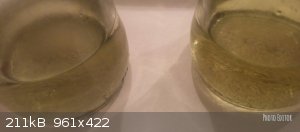
[Edited on 11-10-2018 by AJKOER]
|
|
|